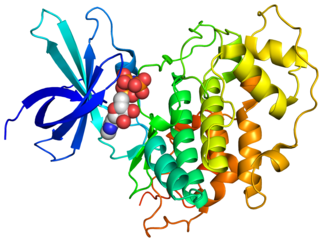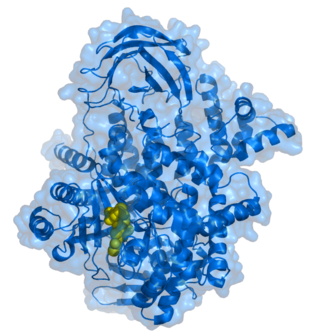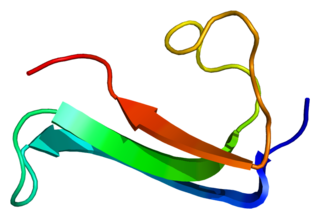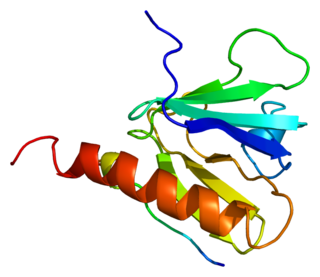Related Research Articles

Brain-derived neurotrophic factor (BDNF), or abrineurin, is a protein that, in humans, is encoded by the BDNF gene. BDNF is a member of the neurotrophin family of growth factors, which are related to the canonical nerve growth factor (NGF), a family which also includes NT-3 and NT-4/NT-5. Neurotrophic factors are found in the brain and the periphery. BDNF was first isolated from a pig brain in 1982 by Yves-Alain Barde and Hans Thoenen.

Glycogen synthase kinase 3 (GSK-3) is a serine/threonine protein kinase that mediates the addition of phosphate molecules onto serine and threonine amino acid residues. First discovered in 1980 as a regulatory kinase for its namesake, glycogen synthase (GS), GSK-3 has since been identified as a protein kinase for over 100 different proteins in a variety of different pathways. In mammals, including humans, GSK-3 exists in two isozymes encoded by two homologous genes GSK-3α (GSK3A) and GSK-3β (GSK3B). GSK-3 has been the subject of much research since it has been implicated in a number of diseases, including type 2 diabetes, Alzheimer's disease, inflammation, cancer, addiction and bipolar disorder.

The restriction point (R), also known as the Start or G1/S checkpoint, is a cell cycle checkpoint in the G1 phase of the animal cell cycle at which the cell becomes "committed" to the cell cycle, and after which extracellular signals are no longer required to stimulate proliferation. The defining biochemical feature of the restriction point is the activation of G1/S- and S-phase cyclin-CDK complexes, which in turn phosphorylate proteins that initiate DNA replication, centrosome duplication, and other early cell cycle events. It is one of three main cell cycle checkpoints, the other two being the G2-M DNA damage checkpoint and the spindle checkpoint.

Protein kinase B (PKB), also known as Akt, is the collective name of a set of three serine/threonine-specific protein kinases that play key roles in multiple cellular processes such as glucose metabolism, apoptosis, cell proliferation, transcription, and cell migration.

Nerve growth factor (NGF) is a neurotrophic factor and neuropeptide primarily involved in the regulation of growth, maintenance, proliferation, and survival of certain target neurons. It is perhaps the prototypical growth factor, in that it was one of the first to be described. Since it was first isolated by Nobel Laureates Rita Levi-Montalcini and Stanley Cohen in 1956, numerous biological processes involving NGF have been identified, two of them being the survival of pancreatic beta cells and the regulation of the immune system.

Phosphoinositide 3-kinases (PI3Ks), also called phosphatidylinositol 3-kinases, are a family of enzymes involved in cellular functions such as cell growth, proliferation, differentiation, motility, survival and intracellular trafficking, which in turn are involved in cancer.
A neurite or neuronal process refers to any projection from the cell body of a neuron. This projection can be either an axon or a dendrite. The term is frequently used when speaking of immature or developing neurons, especially of cells in culture, because it can be difficult to tell axons from dendrites before differentiation is complete.
The MAPK/ERK pathway is a chain of proteins in the cell that communicates a signal from a receptor on the surface of the cell to the DNA in the nucleus of the cell.

Interleukin-31 (IL-31) is a protein that in humans is encoded by the IL31 gene that resides on chromosome 12. IL-31 is an inflammatory cytokine that helps trigger cell-mediated immunity against pathogens. It has also been identified as a major player in a number of chronic inflammatory diseases, including atopic dermatitis.

Midkine, also known as neurite growth-promoting factor 2 (NEGF2), is a protein that in humans is encoded by the MDK gene.

GRB2-associated-binding protein 2 also known as GAB2 is a protein that in humans is encoded by the GAB2 gene.
The ErbB family of proteins contains four receptor tyrosine kinases, structurally related to the epidermal growth factor receptor (EGFR), its first discovered member. In humans, the family includes Her1, Her2 (ErbB2), Her3 (ErbB3), and Her4 (ErbB4). The gene symbol, ErbB, is derived from the name of a viral oncogene to which these receptors are homologous: erythroblastic leukemia viral oncogene. Insufficient ErbB signaling in humans is associated with the development of neurodegenerative diseases, such as multiple sclerosis and Alzheimer's disease, while excessive ErbB signaling is associated with the development of a wide variety of types of solid tumor.

Insulin receptor substrate 1(IRS-1) is a signaling adapter protein that in humans is encoded by the IRS1 gene. It is a 131 kDa protein with amino acid sequence of 1242 residues. It contains a single pleckstrin homology (PH) domain at the N-terminus and a PTB domain ca. 40 residues downstream of this, followed by a poorly conserved C-terminus tail. Together with IRS2, IRS3 (pseudogene) and IRS4, it is homologous to the Drosophila protein chico, whose disruption extends the median lifespan of flies up to 48%. Similarly, Irs1 mutant mice experience moderate life extension and delayed age-related pathologies.

ETS Like-1 protein Elk-1 is a protein that in humans is encoded by the ELK1. Elk-1 functions as a transcription activator. It is classified as a ternary complex factor (TCF), a subclass of the ETS family, which is characterized by a common protein domain that regulates DNA binding to target sequences. Elk1 plays important roles in various contexts, including long-term memory formation, drug addiction, Alzheimer's disease, Down syndrome, breast cancer, and depression.

Ribosomal protein S6 kinase alpha-1 is an enzyme that in humans is encoded by the RPS6KA1 gene.
Trk receptors are a family of tyrosine kinases that regulates synaptic strength and plasticity in the mammalian nervous system. Trk receptors affect neuronal survival and differentiation through several signaling cascades. However, the activation of these receptors also has significant effects on functional properties of neurons.

Ribosomal protein S6 kinase alpha-2 is an enzyme that in humans is encoded by the RPS6KA2 gene.
The Akt signaling pathway or PI3K-Akt signaling pathway is a signal transduction pathway that promotes survival and growth in response to extracellular signals. Key proteins involved are PI3K and Akt.
Collapsin response mediator protein family or CRMP family consists of five intracellular phosphoproteins of similar molecular size and high (50–70%) amino acid sequence identity. CRMPs are predominantly expressed in the nervous system during development and play important roles in axon formation from neurites and in growth cone guidance and collapse through their interactions with microtubules. Cleaved forms of CRMPs have also been linked to neuron degeneration after trauma induced injury.

The PI3K/AKT/mTOR pathway is an intracellular signaling pathway important in regulating the cell cycle. Therefore, it is directly related to cellular quiescence, proliferation, cancer, and longevity. PI3K activation phosphorylates and activates AKT, localizing it in the plasma membrane. AKT can have a number of downstream effects such as activating CREB, inhibiting p27, localizing FOXO in the cytoplasm, activating PtdIns-3ps, and activating mTOR which can affect transcription of p70 or 4EBP1. There are many known factors that enhance the PI3K/AKT pathway including EGF, shh, IGF-1, insulin, and CaM. Both leptin and insulin recruit PI3K signalling for metabolic regulation. The pathway is antagonized by various factors including PTEN, GSK3B, and HB9.
References
- 1 2 3 4 Salto, Rafael; Vílchez, Jose D.; Girón, María D.; Cabrera, Elena; Campos, Nefertiti; Manzano, Manuel; Rueda, Ricardo; López-Pedrosa, Jose M. (2015-08-12). "β-Hydroxy-β-Methylbutyrate (HMB) Promotes Neurite Outgrowth in Neuro2a Cells". PLOS ONE. 10 (8): e0135614. Bibcode:2015PLoSO..1035614S. doi: 10.1371/journal.pone.0135614 . ISSN 1932-6203. PMC 4534402 . PMID 26267903.
- 1 2 LePage KT, Dickey RW, Gerwick WH, Jester EL, Murray TF (2005). "On the use of neuro-2a neuroblastoma cells versus intact neurons in primary culture for neurotoxicity studies". Critical Reviews in Neurobiology. 17 (1): 27–50. doi:10.1615/critrevneurobiol.v17.i1.20. PMID 16307526.
- ↑ Park, Shin-Ji; Jin, Mei Ling; An, Hyun-Kyu; Kim, Kyoung-Sook; Ko, Min Jung; Kim, Cheol Min; Choi, Young Whan; Lee, Young-Choon (2015-02-19). "Emodin induces neurite outgrowth through PI3K/Akt/GSK-3β-mediated signaling pathways in Neuro2a cells". Neuroscience Letters. 588: 101–107. doi:10.1016/j.neulet.2015.01.001. ISSN 0304-3940.
- ↑ Wang, Xiaohui; Wang, Zhuyao; Yao, Yuzhen; Li, Jingjin; Zhang, Xiaojin; Li, Chuanfu; Cheng, Yunlin; Ding, Guoxian; Liu, Li; Ding, Zhengnian (2011-05-01). "Essential role of ERK activation in neurite outgrowth induced by α-lipoic acid". Biochimica et Biophysica Acta (BBA) - Molecular Cell Research. Including the Special Section: 11th European Symposium on Calcium. 1813 (5): 827–838. doi:10.1016/j.bbamcr.2011.01.027. ISSN 0167-4889.
- 1 2 Evangelopoulos, Maria Elephteria; Weis, Joachim; Krüttgen, Alex (2005-05-05). "Signalling pathways leading to neuroblastoma differentiation after serum withdrawal: HDL blocks neuroblastoma differentiation by inhibition of EGFR". Oncogene. 24 (20): 3309–3318. doi:10.1038/sj.onc.1208494. ISSN 1476-5594. PMID 15735700.
- ↑ Sun, Ying-Jian; Long, Ding-Xin; Li, Wei; Hou, Wei-Yuan; Wu, Yi-Jun; Shen, Jian-Zhong (2010-02-01). "Effects of avermectins on neurite outgrowth in differentiating mouse neuroblastoma N2a cells". Toxicology Letters. 192 (2): 206–211. doi:10.1016/j.toxlet.2009.10.021. ISSN 0378-4274. PMID 19879343.
- ↑ Tremblay, Roger G.; Sikorska, Marianna; Sandhu, Jagdeep K.; Lanthier, Patricia; Ribecco-Lutkiewicz, Maria; Bani-Yaghoub, Mahmud (2010-01-30). "Differentiation of mouse Neuro 2A cells into dopamine neurons". Journal of Neuroscience Methods. 186 (1): 60–67. doi:10.1016/j.jneumeth.2009.11.004. ISSN 0165-0270. PMID 19903493.
- ↑ Provost P (2010). "Interpretation and applicability of microRNA data to the context of Alzheimer's and age-related diseases". Aging. 2 (3): 166–169. doi:10.18632/aging.100131. PMC 871245 . PMID 20375468.
- ↑ Ogrodnik M, Salmonowicz H, Brown R, Turkowska J, Sredniawa W, Pattabiraman S, Amen T, Abraham AC, Eichler N, Lyakhovetsky R, Kaganovich D (2014). "Dynamic JUNQ inclusion bodies are asymmetrically inherited in mammalian cell lines through the asymmetric partitioning of vimentin". Proceedings of the National Academy of Sciences of the United States of America . 111 (22): 8049–54. Bibcode:2014PNAS..111.8049O. doi: 10.1073/pnas.1324035111 . PMC 4050583 . PMID 24843142.